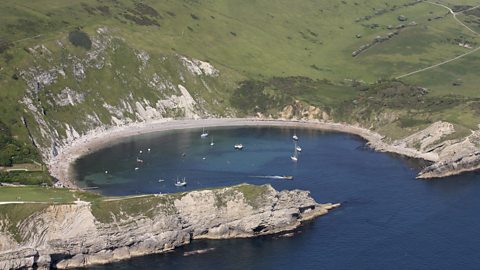Case study - coastal landforms: Dorset coastline
Dorset is located in the south of England. Its coastline has examples of many erosional and depositional landforms. For example:
- Swanage is an example of a headlandA high area of land that extends out into the sea. and bayA low-lying inlet of land on the coast.
- Old Harry Rocks is an example of caves, stacks and stumps
- at Chesil Beach there is a barA spit that has grown across a bay. Also known as barrier beaches.
Swanage Bay
The area around Swanage is made up of bands of hard and soft rock. The soft rock is made of clay and sands, and the hard rock is chalk and limestone. The bands of soft rock erode more quickly than those of the more resistant hard rock leaving a section of land jutting out into the sea, called a headland. The areas where the soft rock has eroded away, next to the headland, are called bays. This process created Swanage Bay, Studland Bay and two headlands, including Durlston Head.
Coastlines where the geology alternates between bands of hard and soft rock which are perpendicularIf the angle between two lines is a right angle, the lines are said to be perpendicular. to the shore are called discordant coastlines.
A concordant coastline has the same type of rock along its length. The alternating bands of hard and soft rock run parallel to the coast. Lulworth Cove is situated on the south coast of England, on a concordant coastline.
The entrance to the cove is narrow where the waves have cut through weaknesses in the resistant limestone. Then the cove widens where the softer clays have been more easily eroded. At the back of the cove is a band of more resistant chalk, so erosion is slower here.

Old Harry Rocks
Old Harry Rocks are located on the headland between Swanage and Studland Bay. The headland is made out of chalk, a hard rock. The headland juts out into the sea, so it is more vulnerable to high-energy waves. This caused the formation of Old Harry, a stack. Over time Old Harry will collapse to form a stump.
Chesil Beach
Chesil Beach is an example of a bar. Sediment has been deposited over time to form a spitA stretch of beach at one end of a coastline caused by waves depositing material.. The spit has continued to join to the Isle of Portland. Behind the spit there is The Fleet, a lagoon.